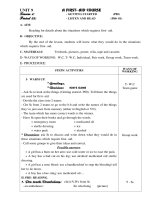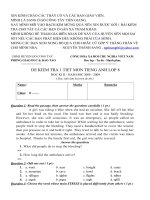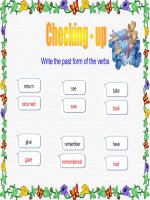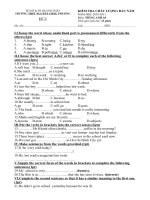T.Anh 10 Unit 9 (chuẩn)
Bạn đang xem bản rút gọn của tài liệu. Xem và tải ngay bản đầy đủ của tài liệu tại đây (196.08 KB, 9 trang )
Unit 9: Un d e rsea w orld
Period 1 : Read ing
I. Aims:
- Ps understand the reading text and through the reading text the students understand and know how to use the
new words correctly
II. Materials: Textbook, whiteboard markers, Cassettes…
III. Procedure:
Teacher Students
1. Warmer:
- Ps close the book and write down all the words they know about the undersea
living things
- The group with the most words will become the winner
- Ex: Shark, dolphin, whale, ……
1-g: a humpback whale
2- f: dolphin: ca heo
3- c: shark: ca map
4- e; a lobster: tom
5- h: sea turtle ; rua bien
6- a: sea horse : ca ngua
7- d: a crab : cua
8- b: a star fish : sao bien
- Group work
2. Before reading:
- Can you name the Sea in the world?
- Teacher writes the first two letters on the board.
Se……………..Je………………, Ju……………………, Sh……………
- Call one student to board and write the Vietnamese name of the Ocean in the
world.
- Suggested answer:
Name of the world ocean:
Arctic Ocean : Bac Doung
Pacific Ocean : Thai Binh Doung
Atlantic Ocean: Dai tay doung
Indian Ocean: An do doung
Antarctic Ocean: Bien Nam Cuc
Animals:
Seal- Jellyfish- Turtle- Shark
- Ask Ps to read the words in chorus
* Pre- teach new words:
- gulf : [gʌlf]vịnh
- bay: Vinh
- challenge ( v) : thu thach
- mystery (n) : bi mat, dieu huyen bi, dieu than bi…
- overcome (v): khac phuc, vuot qua
- submarine (n): tau ngam
- investigate (v): dieu tra, khao sat
- seabed (n) : ['si:'bed]: đáy biển
- sample (n) : mau, vi du
- marine (a) : thouc ve bien, gan bien, do bien sinh ra
- wide range of smt : much, many..
- starfish : (n) : sao bien
- tiny organism : sinh vat/ ca the nho
- Pair
work
- Take
note and
read
after the
teacher
-
- carry along :
- biodiversity (n) : da dang sinh hoc
- to be at a stake : bi de doa
- maintain (v) : duy tri
3. While reading:
- Ss read in silence and then do the tasks followed:
Task 1:
1. tiny
2. reveal
3. gulf
4. Biodiversity
5. samples
Task 2: Read the passage again and then answer the questions:
1/ 75 %
2. By using more sophisticated tools
3. To investigate the seabed and bring samples of the marine life back to the
surface for the further study.
4. provide a wide range of information, including water temperature, depth and
the undersea population.
5. Group 1: live on or depend on the bottom like the starfish
Group 2: swimming animals such as fishes and sharks that more independently
of water
Groups 3: Tiny organisms that are carried along by the currents like the
jellyfish.
6. If the sea biodiversity was not maintained, the marine life would be at stake
4. After reading: Complete the summary of the reading text by filling gin the
blank with a suitable word
1. Three- quarters
2. mysterious
3. modern
4. discoveries
5. plants and animals
6. huge
7. biodiversity
8. closely connected
- Pair work
5. Home work : In work book ( p49)
I I I. Self e v a luation :
.. . . . .. . . . .. . . . . .. . . . .. . . . .. . . . ... . . . .. . . . .. . . . .. . . . . .. . . . .. . . . .. . . . ... . . . .. . . . .. . . . .. . . . . .. . . . .. . . . .. . . . ... . . . .. . . . .. . . . .. . . . . . . . . . . . ….
.. . . . .. . . . .. . . . . .. . . . .. . . . .. . . . ... . . . .. . . . .. . . . .. . . . . .. . . . .. . . . .. . . . ... . . . .. . . . .. . . . .. . . . . .. . . . .. . . . .. . . . ... . . . .. . . . .. . . . .. . . . . . . . . . . . ….
……………………………………………………………………………………………………………
……………………………………………………………………………………………………………
……………………………………………………………………………………………………………
……………………………………………………………………………………………………………
Unit 9: Un d e rsea w orld
Period 2: Speaking
I. Aims:
- By the end of the lesson, students will be able to talk about the protection of sea environment
- Know how to use some words relating to the topic.
II. Materials: Textbook, whiteboard markers, Cassettes…
III. Procedure :
Teacher Students
1. Warmer: Class discussion: What are the problems of the undersea world?
What is the most serious?
- Environment is polluted be cause of much rubbish thrown into the sea.
- Many kinds of animals are in danger and will soon become extinct because of
too much hunting
- Oil is spilled from the tankers
- Beaches are filled with rubbish
- Group
discuss
ion
-
2. Pre- Speaking:
a. Pre- teach new words:
- rubbish: rac thai
- sparingly (adv) : tiet kiem
- species (n) : loai, loai
- limit, threaten, endanger (n)
- Dispose (v) : thai, vut bo
- Fishing lines, fishing nets : day cau, luoi cau
- Herbicide (n) : ['hə:bisaid]: thuốc diệt cỏ
- Pesticide (n) ['pestisaid]: thuốc diệt loài gây hại, thuốc trừ sâu
- Fertilizer (n) :phan bon
- Smart : (a) : thong minh, khon ngoan…
- Take
note
- Listen
- Read
after
the
teacher
3. While- Speaking:
Task 1: Put the actions in the order of importance and then say what we should do
or should not do.
- In your opinion, which action should you do to protect the oceans first ? and why ?
- Which action shouldn’t you do?
- What do you think of using herbicides?
- How do you feel about being a smart shopper?
- Well, I think .…
- In my opinion . We should . Because .… … …
Task 2: Discuss the consequences that might occur and offer some possible
solutions.
Threats Consequences Solutions
1. Beaches filled with
plastic bags
Polluted water Place plastic bags in
proper dustbins
2. Whales hunted for food Extinct/ disappear Governments don’t let
people sell whale products
3/ Explosives used to
catch fish
A lot of fish died
Pollute the environment
Be banned
4/ Oil spilled from tankers Polluted water Punish captain
- Work
in
pairs
- Group
work
4. Post- Speaking : Report to the class what your group has discussed.
-
5. Homework: Write a report to the teacher on the things they discuss in class
-
IV. Self ev a l uation:
.. . . . .. . . . .. . . . . .. . . . .. . . . .. . . . ... . . . .. . . . .. . . . .. . . . . .. . . . .. . . . .. . . . ... . . . .. . . . .. . . . .. . . . . .. . . . .. . . . .. . . . ... . . . .. . . . .. . . . .. . . . . . . . . . . . ….
.. . . . .. . . . .. . . . . .. . . . .. . . . .. . . . ... . . . .. . . . .. . . . .. . . . . .. . . . .. . . . .. . . . ... . . . .. . . . .. . . . .. . . . . .. . . . .. . . . .. . . . ... . . . .. . . . .. . . . .. . . . . . . . . . . . ….
……………………………………………………………………………………………………………
……………………………………………………………………………………………………………
……………………………………………………………………………………………………………
……………………………………………………………………………………………………………
Unit 9: Un d e rsea w orld
Period 3: Listeni ng
I. Aims:
- By the end of the lesson, students will be able to listen and understand the content of the listening text. And do
correctly all the tasks followed.
II. Materials: Textbook, whiteboard markers, Cassettes…
III. Procedure :
Teacher Students
1. Warmer:
2. Pre- listening:
- Do you think whales are fish? Why (not)?
Whales are not fish because they raises their young on milk
- Why do people keep hunting whales?
Because they want to catch whales for food, oil leather and other products
- Pre- teach new words:
Mammal ( n) : thu co vu
Krill : laoi nhuyen the ma ca voi an douc
Whaling: su san ca voi, nghe san ca voi
Migrate : /mai'greit/ (v): di tru, di cu
Conservation:/ ,kɔnsə:'vei∫n/ : su bao ton moi troung thien nhien
3.While - listening:
a. Task 1:
1F, 2T, 3T, 4F, 5T
b. Task 2:
1. The blue whale grows to 30 meters in length and over 200 tons in weight.
2. Because there is a lot of krill-their favorite food in cold water
3. Cold water in the North and South Pacific Atlantic Ocean and the North and South Pacific
are their good feeding ground.
4. Heavy hunting is the main reason for the decrease in whale population
5. They have asked International Whaling Commission to stop most whaling.
6. If we didn’t take any measures to protect whales, whales would disappear forever.
4. Post- listening: Talk about the whales using the cues given.
V. Self e v a luatio n :
.. . . . .. . . . .. . . . . .. . . . .. . . . .. . . . ... . . . .. . . . .. . . . .. . . . . .. . . . .. . . . .. . . . ... . . . .. . . . .. . . . .. . . . . .. . . . .. . . . .. . . . ... . . . .. . . . .. . . . .. . . . . . . . . . . . ….
.. . . . .. . . . .. . . . . .. . . . .. . . . .. . . . ... . . . .. . . . .. . . . .. . . . . .. . . . .. . . . .. . . . ... . . . .. . . . .. . . . .. . . . . .. . . . .. . . . .. . . . ... . . . .. . . . .. . . . .. . . . . . . . . . . . ….
……………………………………………………………………………………………………………
……………………………………………………………………………………………………………
……………………………………………………………………………………………………………
……………………………………………………………………………………………………………









